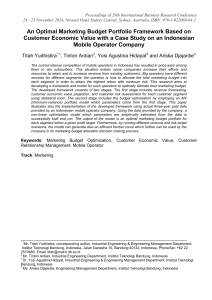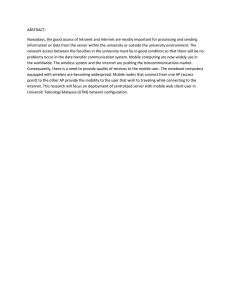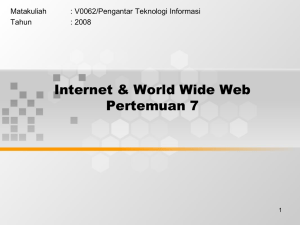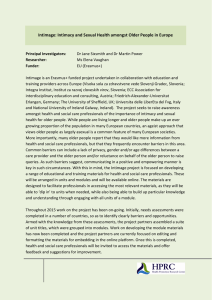Chemical Engineering Thermodynamics I Course Presentation
advertisement
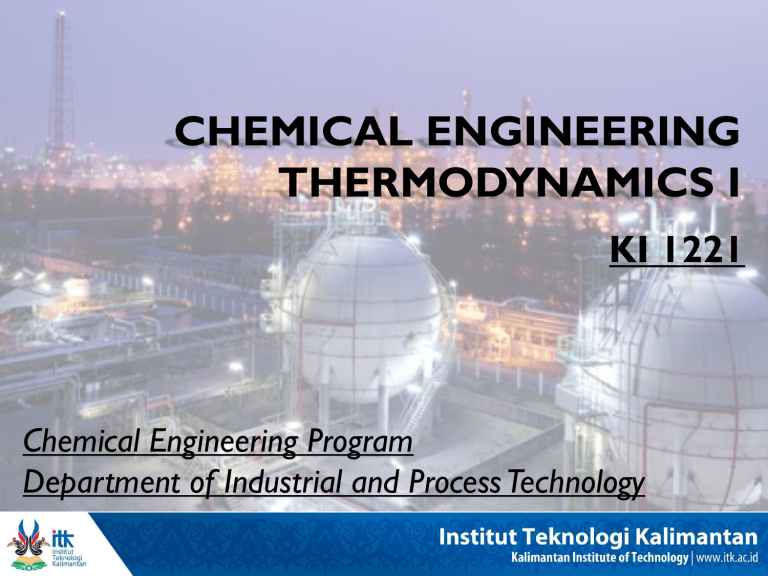
CHEMICAL ENGINEERING THERMODYNAMICS I KI 1221 Chemical Engineering Program Department of Industrial and Process Technology Rancangan Pembelajaran Mata Kuliah Kode / SKS Tujuan Pustaka : Termodinamika Teknik Kimia I : KI 1221 / 3 SKS : Agar mahasiswa menguasai penyelesaian problem pada unit – unit operasi dengan mengaplikasikan hukum 1 & II termodinamika, persamaan keadaan (EoS), panas reaksi, efek panas, serta siklus rankine dan siklus carnot : Smith, J. M., Van Ness, H. C., and Abbott, M. M. (2001); Introduction to Chemical Engineering Thermodynamics 6th edition; McGraw-Hill Book Company Institut Teknologi Kalimantan Rancangan Pembelajaran Materi Pokok : - Hukum I dan II Termodinamika - PVT Behavior - Konsep gas ideal dan gas nyata - Persamaan keadaan (EoS) - Thermodynamics Networking - Heat Effects - Entropy Balance dan Lost of Work - Siklus Carnot, Siklus Rankine, dll Institut Teknologi Kalimantan Rancangan Pembelajaran Garis Besar Perkuliahan Minggu ke- Pokok Bahasan Uraian 1 Hukum I Termodinamika • Pengantar Termodinamika • Hukum I Termodinamika • Neraca Energi pada Sistem Tertutup • Phase Rule • Proses Reversible 2 Idem • Constant-V and Constant-P Process • Kapasitas Panas • Neraca Massa Energi pada Sistem Terbuka 3 Volumetric Properties pada Fluida Murni • PVT Behavior • Persamaan Keadaan Virial Institut Teknologi Kalimantan Rancangan Pembelajaran Garis Besar Perkuliahan Minggu ke- Pokok Bahasan Uraian 4 Idem • Gas Ideal • Persamaan Keadaan Kubik 5 Idem • Generalized Correlations for Gases • Generalized Correlations for Liquids 6 Heat Effects • Efek Panas Sensibel • Panas Laten pada Zat Murni 7 Idem • Heat of Reaction • Heat of Formation • Heat of Combustion 8 Evaluasi Tengah Semester Institut Teknologi Kalimantan Rancangan Pembelajaran Garis Besar Perkuliahan Minggu ke- Pokok Bahasan Uraian 9 Hukum 2 Termodinamika • Hukum 2 Termodinamika • Entropi 10 Idem • Perubahan Entropi pada Gas Ideal • Model Matematika Hukum 2 Termodinamika 11 Idem • Neraca Entropi • Perhitungan Ideal of Work 12 Properties Termodinamika pada Fluida • Hubungan Properties pada Fase Homogen • Residual Properties • Residual Properties dari EoS 13 Idem • Sistem Dua Fase • Diagram Termodinamika • Hubungan Properties Umum untuk Gas Institut Teknologi Kalimantan Rancangan Pembelajaran Garis Besar Perkuliahan Minggu ke- Pokok Bahasan Uraian 14 Aplikasi Termodinamika • Steam Power Plant • Siklus Rankine • Siklus Carnot • Diesel Engine • Gas-Turbine Engine 15 Idem • Carnot Refrigerator • Siklus Kompresi Uap • Refrigerant • Proses Liquefaction 16 Evaluasi Akhir Semester Institut Teknologi Kalimantan Rancangan Pembelajaran Penilaian No. Jenis Penilaian Bobot Penilaian 1 Tugas Kelas 25 % 2 Evaluasi Tengah Semester 30 % 3 Evaluasi Akhir Semester 35 % 4 Kehadiran 10 % Institut Teknologi Kalimantan Scope of Thermodynamics Thermodynamics Law Physical and Chemical Processes Equilibrium Properties Estimation Institut Teknologi Kalimantan Measures of Amount or Size Spesific Volume 𝑉𝑡 𝑉≡ 𝑚 𝑎𝑡𝑎𝑢 𝑉 𝑡 = 𝑚𝑉 Molar Volume 𝑉𝑡 𝑉≡ 𝑛 𝑎𝑡𝑎𝑢 intensive property Institut Teknologi Kalimantan 𝑉 𝑡 = 𝑛𝑉 extensive property Dimensions of Science Force Temperature Pressure Work Energy Heat Energy Conservation Institut Teknologi Kalimantan Exercise...... At what absolute temperature do the Celcius and Fahrenheit temperature scales give the same numerical value? What is the value? The variation of fluid pressure with height is described by 𝑑𝑃 = −𝜌𝑔 𝑑𝑧 Here, ρ is spesific density and g is the local acceleration of gravity. For an ideal gas, ρ = MP/RT, where M is molar mass and R is the universal gas constant. Modeling the atmosphere as an isothermal column of ideal gas at 10oC, estimate the ambient pressure in Denver, where z = 1 (mile) relative to sea level. For air, take M = 29 g/mol; values of R are 82,06 cm3. atm/mol. K Institut Teknologi Kalimantan First Law of Thermodynamics Although energy assumes many forms, the total quantity of energy is constant, and when energy disappears in one form it appears simultaneously in other forms ∆(Energy of the system) + ∆(Energy of surroundings) = 0 Institut Teknologi Kalimantan Energy Balance for Closed Systems W ∆(Energy of surroundings) = ± Q ± W ∆(Energy of surroundings) = - Q – W Closed Systems ∆(Energy of the systems) = Q + W ∆Ut = Q + W Where, Ut = mU or Ut = nU Q Surroundings ∆(nU) = n ∆U = Q + W Although Vt and Ut for a homogeneous system of arbitrary size are extensive properties, spesific and molar volume V (or density) and spesific and molar internal energy U are intensive Institut Teknologi Kalimantan Thermodynamic State and State Functions 𝑑𝑈 𝑡 = 𝑑𝑄 + 𝑑𝑊 Thermodynamic State 𝑉2 𝑃2 𝑑𝑃 = 𝑃2 − 𝑃1 = ∆𝑃 𝑃1 𝑑𝑉 = 𝑉2 − 𝑉1 = ∆𝑉 𝑉1 State Functions 𝑑𝑄 = 𝑄 Institut Teknologi Kalimantan 𝑑𝑊 = 𝑊 Process Functions Example..... a) b) When a system is taken from state a to state b along path acb, 100 J of heat flows into the system and the system does 40 J of work. How much heat flows into the system along path aeb if the work done by the system is 20 J ?? The system returns from b to a along path bda. If the work done on the system is 30 J, does the system absorb or liberate heat?? How much?? 𝑡 ∆𝑈𝑎𝑏 = 𝑄𝑎𝑐𝑏 + 𝑊𝑎𝑐𝑏 = 100 − 40 = 60 𝐽 For path aeb, 𝑡 ∆𝑈𝑎𝑏 = 60 = 𝑄𝑎𝑒𝑏 + 𝑊𝑎𝑒𝑏 = 𝑄𝑎𝑒𝑏 − 20 𝑄𝑎𝑒𝑏 = 80 𝐽 For path bda, 𝑡 𝑡 ∆𝑈𝑏𝑎 = −∆𝑈𝑎𝑏 = −60 = 𝑄𝑏𝑑𝑎 + 𝑊𝑏𝑑𝑎 = 𝑄𝑏𝑑𝑎 + 30 𝑄𝑏𝑑𝑎 = −60 − 30 = −90 𝐽 Institut Teknologi Kalimantan The Phase Rule 𝐹 =2−𝜋+𝑁 π, the number of phases N, the number of chemical species F, the degrees of freedom of the system Institut Teknologi Kalimantan The Reversible Process A process is reversible when its direction can be reversed at any point by an infinitesimal change in external conditions Reversible Expansion of Gas 𝑑𝑊 = −𝑃 𝑑𝑉 𝑡 Surrounding 𝑉2𝑡 𝑊=− System Institut Teknologi Kalimantan 𝑉1𝑡 𝑃 𝑑𝑉 𝑡 The Reversible Process A process is reversible when its direction can be reversed at any point by an infinitesimal change in external conditions Reversible Chemical Reaction 𝐶𝑎𝐶𝑂3 (𝑠) ⇄ 𝐶𝑎𝑂(𝑠) + 𝐶𝑂2 (𝑔) Institut Teknologi Kalimantan Exercise..... One mole of gas in a closed system undergoes a four-step thermodynamic cycle. Use the data given in the following table to determine numerical values for the missing quantities, i.e.,“fill in the blanks”. Step ∆Ut Q W 12 -200 ??? -6000 23 ??? -3800 ??? 34 ??? -800 300 41 4700 ??? ??? 12341 ??? ??? -1400 A tank containing 20 kg of water at 20 oC is fitted with stirer that delivers work to the water at the rate of 0,25 kW. How long does it take for the temperature of the water to rise to 30 oC if no heat is lost from the water? For water, Cp = 4,18 kJ/kg. oC Institut Teknologi Kalimantan Assignment I Do it the problems at Smith Van Ness number 2.9; 2.13 !!! Institut Teknologi Kalimantan Constant-V and Constant-P Processes 𝑑 𝑛𝑈 = 𝑑𝑄 + 𝑑𝑊 𝑑𝑊 = −𝑃 𝑑(𝑛𝑉) 𝑑 𝑛𝑈 = 𝑑𝑄 − 𝑃 𝑑(𝑛𝑉) Constant-Volume Process 𝑑𝑄 = 𝑑 𝑛𝑈 (const.V) Integration yields, 𝑄 = 𝑛 ∆𝑈 Institut Teknologi Kalimantan (const.V) Constant-V and Constant-P Processes Constant-Pressure Process 𝑑𝑄 = 𝑑 𝑛𝑈 + 𝑃 𝑑(𝑛𝑉) 𝑑𝑄 = 𝑑 𝑛𝑈 + 𝑑 𝑛𝑃𝑉 = 𝑑[𝑛 𝑈 + 𝑃𝑉 ] 𝐻 ≡ 𝑈 + 𝑃𝑉 𝑑𝑄 = 𝑑(𝑛𝐻) Integration yields, 𝑄 = 𝑛 ∆𝐻 Institut Teknologi Kalimantan (const. P) Enthalpy 𝑑𝐻 = 𝑑𝑈 + 𝑑(𝑃𝑉) 𝑑𝐻 = 𝑑𝑈 + 𝑃 𝑑𝑉 + 𝑉 𝑑𝑃 Constant Volume Surroundings Constant Pressure System ∆𝐻 = ∆𝑈 + ∆(𝑃𝑉) Institut Teknologi Kalimantan (U, P, dan V) Heat Capacity 𝑑𝑄 𝐶≡ 𝑑𝑇 Heat Capacity at Constant Volume 𝜕𝑈 𝐶𝑉 ≡ 𝜕𝑇 𝑉 Heat Capacity at Constant Pressure 𝜕𝐻 𝐶𝑃 ≡ 𝜕𝑇 𝑃 Institut Teknologi Kalimantan Mass and Energy Balances for Open Systems Mass Balance for Open Systems 𝑑𝑚𝑐𝑣 +∆ 𝑚 𝑑𝑡 𝑓𝑠 =0 Steady State ∆ 𝑚 𝑓𝑠 = 𝑚3 − 𝑚2 − 𝑚1 𝑢1 𝐴1 𝑢2 𝐴2 𝑢𝐴 𝑚= = = 𝑉1 𝑉2 𝑉 Institut Teknologi Kalimantan Mass and Energy Balances for Open Systems General Energy Balance 𝑑 𝑚𝑈 𝑑𝑡 𝑐𝑣 +∆ Institut Teknologi Kalimantan 1 2 𝐻 + 𝑢 + 𝑔𝑧 𝑚 2 =𝑄+𝑊 𝑓𝑠 Mass and Energy Balances for Open Systems Energy Balances for Steady State Flow Processes 𝑑 𝑚𝑈 𝑑𝑡 𝑐𝑣 +∆ 1 2 𝐻 + 𝑢 + 𝑔𝑧 𝑚 2 =𝑄+𝑊 𝑓𝑠 ∆𝑢2 ∆𝐻 + + 𝑔 ∆𝑧 = 𝑄 + 𝑊 2 ∆𝐻 = 𝑄 + 𝑊 Institut Teknologi Kalimantan Exercise...... Water flows through a horizontal coil heated from the outside by high-temperature flue gases. As it passes through the coil, the water changes state from liquid at 200 kPa and 80oC to vapor at 100 kPa and 125oC. Its entering velocity is 3 m/s and its exit velocity is 200 m/s. Determine the heat transferred through the coil per unit mass of water. Enthalpies of the inlet and outlet streams are 334,9 kJ/kg and 2726,5 kJ/kg Institut Teknologi Kalimantan Assignment II Do it the problems at Smith Van Ness, number 2.19; 2.27; 2.31 !!! Institut Teknologi Kalimantan
